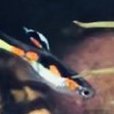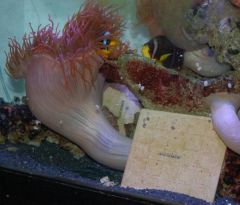-
Posts
1,462 -
Joined
-
Last visited
Content Type
Profiles
Forums
Gallery
Events
Store
Everything posted by traveller7
-
Halfway down the page, septicemia: http://www.afip.org/vetpath/POLA/99/Diseases_of_Fish.htm I have found removal of stress, adressing water quality, and adding a varied diet fairly effective. Antibiotics in the near term to halt disease, but the stressor must be removed to prevent return. Good luck with that pretty fish.
-
Cliff, Have no clue how you are going to haul all those barrels around, but if they have 2-55g's and you have space, I'll be ready to pick up at the meeting :>) fwiw: I may plan a run over the summer and can likely carry 6-8 in my vehicle. Cheers and thanks for your efforts. Scott
-
Such a position would likely draw air bubbles into the closed loop, pumping them back into the tank. You might be able to pull it off but IMHO I it would not be worth the risk of hassles.
-

I've done something very wrong with my closed loop it seems.
traveller7 replied to CHUBAKAH's topic in Do It Yourself
lol amazing the change in meaning when mistakenly using "from" in place of "to" :D -

I've done something very wrong with my closed loop it seems.
traveller7 replied to CHUBAKAH's topic in Do It Yourself
That's alright, my original estimate included all the fittings at the top which in this picture appear to be returns from the sump -

I've done something very wrong with my closed loop it seems.
traveller7 replied to CHUBAKAH's topic in Do It Yourself
I am going to try one of those in a current project....IMHO, they are a new design...might want to wait a bit. Do you have a 400-600gph power head to compare the single output flow too? If they are similar, it could give us a baseline to tweak from. If greater, a solution allow 2 to run at a time, if less, a single output at a time Flow demands will depend on your target species, I am not an SPS guy, but I know my anemones are upset with me if my alternating flow is below the "400-600gph" ranges. I am under the impression sps would like much greater, but best to hear from more experienced folks. -

I've done something very wrong with my closed loop it seems.
traveller7 replied to CHUBAKAH's topic in Do It Yourself
Have you tried to close off all but one return? A cap on all but one in the tank should do it. If that is "enough" flow, it is possible a flow alternating device will be sufficient. Fine tuning the return line during that stage should give you a drastic improvement as well. -

I've done something very wrong with my closed loop it seems.
traveller7 replied to CHUBAKAH's topic in Do It Yourself
The first question is actually, "What is the target flow?"Then calculate system head. Then choose pump which meets the target flow. fwiw: If you can't tell, I think your pump is fine. Spend $ on the pvc and possibly add an oceans motion, sqwd, etc. -

I've done something very wrong with my closed loop it seems.
traveller7 replied to CHUBAKAH's topic in Do It Yourself
Don't forget the loss on the intake side, in this case it appears substantial as well. If you can't feed the pump, why would you expect anything to come out the other side? Intake strainers, elbows, valves, input count, 1" pipe, etc., all negatively impact this design on the intake side. I'll save you the trouble of signing up for the class: What is Pump Head? Units of Measure: In the U.S. system, head is measured either in PSI or in "feet of head" (usually abbreviated to "feet"). Pump Head is the total resistance that a pump must overcome. It consists of the following components: Static Head: Static head represents the net change in height, in feet, that the pump must overcome. It applies only in open systems. Note that in a closed loop system, the static head is zero because the fluid on one side of the system pushes the fluid up the other side of the system, so the pump does not need to overcome any elevation. Friction Head: This is also called pressure drop. When fluid flows through any system component, friction results. This causes a loss in pressure. Components causing friction include boilers, chillers, piping, heat exchangers, coils, valves, and fittings. The pump must overcome this friction. Friction head is usually expressed in units called "feet of head." A foot of friction head is equal to lifting the fluid one foot of static height. Pressure Head: When liquid is pumped from a vessel at one pressure to a vessel at another pressure, pressure head exists. Common applications include condensate pumps and boiler feed pumps. Condensate pumps often deliver water from an atmospheric receiver to a deaerator operating at 5 PSIG, meaning that in addition to the other heads, the pump must overcome a pressure head of 5 PSIG. One PSIG equals 2.31 feet, so the differential head in this application is 5 X 2.31 = 11.6. -

I've done something very wrong with my closed loop it seems.
traveller7 replied to CHUBAKAH's topic in Do It Yourself
Water pressure is the same, until you turn the pump on, then pressure is less on the intake, higher on the output. Once turned on, a pump sees -

I've done something very wrong with my closed loop it seems.
traveller7 replied to CHUBAKAH's topic in Do It Yourself
You have one opinion based on a few pictures, take it with a grain of salt until proven through testing ;>) -

I've done something very wrong with my closed loop it seems.
traveller7 replied to CHUBAKAH's topic in Do It Yourself
Yes, drastic issues are in the design itself. Calculate the head value. If I understand the plumbing depicted: The plumbing design creates too much resistance. You will get low amount of flow out of each output, if any. You can test the theory by closing off 3 inputs, and 3 outputs which reduces the flow through all the 1" pipe, fittings and elbows. If the total flow increases substantially, tweak by opening and closing outputs one at a time. IME, you would find a substantial increase by utilizing a single larger input, and alternating the outputs to allow only a single/dual to be open at a time. Of course, you can overcome plumbing issues with a more expensive power sucking heat introducing pump. Best of luck. -

I've done something very wrong with my closed loop it seems.
traveller7 replied to CHUBAKAH's topic in Do It Yourself
Wow, that is one heck of alot of head loss from plumbing alone. Have run run the fittings and pipe against a calculator? Ran a quick estimate and head loss(input and output) looks like it is over 25' and it appears you are running the following pump: 100PX-X 1270gph 13' 130W 1" MPT / 1" MPT 10.5"x4"x5.5" 40RLXT Is that correct? edit: fwiw this is the calculator I was using: http://reefcentral.com/calc/hlc2.php -
Aeration tends to improve such changes greatly. IME, adding a power head with venturi or maybe 2 works pretty well :>)
-
Algae and anemones with brown color are telling me I have plenty of Nitrates. I am not managing, measuring, or monitoring Nitrates except when attempting to hatch/raise fry. I will step up to weekly waterchanges at that time. See above. fwiw: My larger system utilized a remote deep sand bed which kept up with nitrate product for quite awhile, but even it was unable to keep pace with the bio load in eventually.
-
First saltwater was not until 1979. 10gal left over from freshwater upgrades. Air Driven UG Filter(salt creep quickly forced an upgrade to a power head...you know the ones that had the motors, fans, etc. above the water line :D ) Dolomite substrate, dead coral skeletons, NO lighting. Mix of all the disasterous selections, but the hook on the SW side of the house was a Catalina goby, still one of my favorites
-
What Ed said :>) The anemone's response was predictable. Odds are high it will be fine, but try to stay with 1cm x 1cm chunks in the future. The smaller pieces are better for your anemone, and your tank. If you had seen the anemone 1-2 hours later, it would likely have looked fine, but you would have a 1.5" piece of shrimp rotting in your tank somewhere. Not a good thing for anything in the tank.
-

how do you treat popeye in a fish that wont eat
traveller7 replied to jamal's topic in General Discussion
If medicating an unknown cause, I tend to go mild broad spectrum, say Maracyn combined with Maracyn2. QT tanks are notorius for declining water conditions, they typically don't have the established support systems so keep an eye on them. Might want to check nitrates, if they are high in the QT, it had ammonia at some point. Better safe then sorry Best of luck with them. -

how do you treat popeye in a fish that wont eat
traveller7 replied to jamal's topic in General Discussion
While it is possibly damage from skittish behavior, it is more likely water quality with angels. When popeye arises in QT, suspect an ammonia spike or pH crash, or even both. Especially if the eyes are clouded. Most instances can be addressed with clean water of proper conditions. If a bubble forms behind the eye, a needle may be necessary. A small bit of protrusion from water quality or mild infection will typically subside on its own. You can dose anti bacterial meds to prevent further issues and make sure the tank lighting/activity around the QT is dim and quiet respectively. Edit, wow, I am typing and spelling well tonight -
Really long chopsticks, the type they use for cooking. If you are not a fan of sushi, use one long wooden chopstick with a needle stuck in the end. fwiw: clowns have been known to chase anemones into hiding as well. If the tentacles are bent, broken off, twisted harshly, missing, etc., the anemone may need to be nursed back to health in isolation.
-
The Sulfur Denitrator thread: http://www.reefcentral.com/forums/showthre...mp;pagenumber=1
-
It sounds mildly bleached at a minimum, so it should be feed meaty foods to compensate. Feeding stick with a 1cm x 1cm piece of soft bodied fish on the end would be my plan. Another indicator in this case, bleached anemones tend to hide from the lighting. Maybe check on it after lights out and before lights on, if it grows larger when the lights are off, it may be easier to reach a few tentacles. If it reacts to the 1cm x 1cm piece of fish, it will pull it right in immediately. Best of luck.
-
Mine can almost eat basketballs, but they don't get large food. They get what blows by for the clowns, which is ~1oz a day of mysis/brine/etc. They get lancefish when I am not lazy. They get lighting from 150wt MHs. Such a regimen is obviously not inhibiting growth, they don't divide in my tank until they are >12" across the disk. For size reference, the tile is 6"x6" and a top down view shows the anemone ~13" across the top.
-
-
They eat anything that blows by, but the really like Lancefish, from TMC/Gamma Foods.



